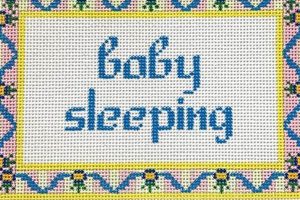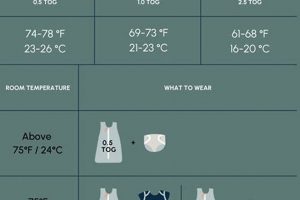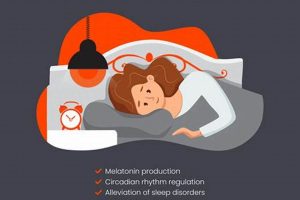The practice of placing an infant in a supportive, horseshoe-shaped pillow designed for nursing and lounging is a common one. This item, often made of soft fabric and filled with cushioning material, provides a semi-reclined position. Anecdotal evidence suggests that parents use this product to allow their baby to rest comfortably, especially after feeding.
Its perceived value lies in offering a safe and comfortable spot for the infant, potentially aiding in digestion and minimizing reflux. Originally conceived as a nursing aid, its use has expanded to include providing a supportive environment for the baby. However, guidelines from health organizations advise against unsupervised infant sleep in inclined or unsupported positions due to safety concerns.
This product’s widespread use raises important considerations regarding the safety of positioning infants for sleep. The following analysis will examine the recommended sleep practices for infants, the specific concerns associated with non-crib environments, and guidance to minimize risks.
Recommendations for Safe Infant Sleep Practices
The information below offers guidelines pertaining to infant sleep safety. These recommendations are intended to minimize the risk of sleep-related incidents.
Tip 1: Prioritize a Firm, Flat Sleep Surface: Infants should be placed on a firm mattress in a safety-approved crib, bassinet, or play yard. Avoid soft surfaces that can conform to the infant’s shape.
Tip 2: Maintain a Clear Sleep Environment: The sleep area should be free of loose bedding, pillows, blankets, and toys. These items pose a suffocation risk.
Tip 3: Supervise While Awake and Minimize Inclined Positioning: If an infant is placed in an inclined position (e.g., in a swing or bouncer) while awake, continuous monitoring is imperative. Inclined positions are not safe for unsupervised sleep.
Tip 4: Adhere to Back Sleeping Recommendations: Infants should be placed on their backs for sleep, unless otherwise advised by a medical professional due to specific medical conditions.
Tip 5: Consistent Sleep Environment: Establish a regular sleep routine and environment to signal to the infant that it is time for rest.
Tip 6: Avoid Overheating: Dress the infant in light clothing appropriate for the room temperature. Avoid over-bundling or using excessive blankets.
Following these recommendations can greatly contribute to a safer sleep environment for infants, minimizing the potential for hazardous sleep conditions.
These practices should be considered in the broader context of infant care, alongside regular consultations with healthcare providers.
1. Suffocation Risk
The potential for suffocation constitutes a primary safety concern when infants are placed in supportive pillows. The soft, pliable nature of these items, designed to conform to the user, can inadvertently obstruct an infant’s airway if the baby shifts or rolls into a position that presses their face against the pillow’s surface. This obstruction impedes normal breathing, leading to a critical reduction in oxygen intake.
Instances of infant deaths linked to supportive pillows often cite airway obstruction as a contributing factor. The lack of rigid structure in these products contrasts sharply with the firm, flat surface recommended for infant sleep, highlighting the inherent risk. Unlike a crib mattress, a pillow can easily mold around a baby’s face, trapping them in a hazardous situation they are unable to escape. The combination of a vulnerable infant and an adaptable pillow creates a scenario where suffocation can occur rapidly and silently.
Therefore, awareness of this suffocation risk is essential. Recommendations prioritize a clear, unencumbered sleep environment, emphasizing the avoidance of soft bedding, pillows, and similar items. Adherence to these guidelines represents a critical step in safeguarding infants from this life-threatening hazard. Consistent application of safe sleep practices serves as the most effective preventative measure.
2. Positional Asphyxia
Positional asphyxia, a form of respiratory failure, occurs when an individual’s body position prevents adequate breathing. In the context of infant sleep environments, specifically the use of supportive pillows, the risk of positional asphyxia is a significant concern. The semi-reclined or slumped posture an infant assumes when placed on such a pillow can lead to airway compromise. This occurs when the infant’s chin rests on their chest, constricting the trachea and impeding airflow. Unlike adults, infants lack the muscle strength and head control to reposition themselves effectively when breathing becomes difficult.
The design of some supportive pillows may inadvertently exacerbate this risk. The soft, yielding materials offer inadequate support to maintain an open airway, particularly if the infant lacks the ability to lift or turn their head. For example, if an infant rolls slightly to the side, the pillow could press against their face, further limiting airflow and increasing the risk of suffocation. Instances reported in medical literature and consumer safety alerts describe cases where infants found in such positions exhibited signs of respiratory distress or, tragically, were found unresponsive. These scenarios underscore the potential for seemingly innocuous sleep aids to create hazardous conditions.
Mitigation of positional asphyxia necessitates strict adherence to safe sleep guidelines. The recommendation for infants to sleep on their backs on a firm, flat surface, devoid of pillows or soft bedding, is directly aimed at preventing such incidents. Public awareness campaigns emphasize these guidelines to parents and caregivers, highlighting the importance of creating a safe sleep environment to minimize the risk of positional asphyxia and other sleep-related infant deaths. Vigilance and consistent application of established safe sleep practices remain crucial in protecting infants from these preventable tragedies.
3. Lack of Support
The attribute of insufficient support, specifically in the context of infant positioning devices, constitutes a significant consideration for infant safety. This analysis explores facets of inadequate support mechanisms.
- Inadequate Spinal Alignment
Support pillows often fail to provide the necessary support for proper spinal alignment in infants. An infant’s spine, particularly in the early months, requires a firm, flat surface to promote healthy development. The yielding nature of these pillows can lead to unnatural curvature and potential strain on the spinal column. The absence of a solid foundation contributes to instability, especially when the infant shifts or moves during sleep.
- Compromised Head Control
Infants possess limited head control, particularly in the initial months of life. Insufficient support around the head and neck can lead to the infant’s head slumping forward, potentially obstructing their airway. The lack of a structured headrest mechanism within such pillows exacerbates this risk. The inability to maintain an open airway presents a critical safety hazard, increasing the possibility of positional asphyxia.
- Absence of Lateral Stability
Support pillows may not offer adequate lateral stability, particularly for infants who are developing their ability to roll over. This lack of side support increases the likelihood of the infant rolling into an unsafe position, such as onto their stomach, which elevates the risk of Sudden Infant Death Syndrome (SIDS). A stable, secure sleep environment minimizes the potential for unintended positional changes that could compromise the infant’s breathing or overall well-being.
- Unreliable Surface Consistency
The consistency of the support surface is often compromised due to the pliable materials used in these pillows. Over time, the filling may shift or compress, creating uneven support and potential pressure points. This inconsistent surface can disrupt the infant’s sleep and contribute to discomfort. A reliable, uniform surface is essential for promoting restful and safe sleep.
These elements of insufficient support highlight the potential dangers associated with positioning infants on yielding surfaces. Understanding these facets is essential for mitigating risks and prioritizing established safe sleep practices, emphasizing a firm, flat surface for infant sleep.
4. Unsafe Inclination
The term “unsafe inclination” refers to positioning an infant at an angle that compromises their breathing or increases the risk of positional asphyxia. The connection between “unsafe inclination” and the practice of placing an infant in a supportive pillow is direct and consequential. Supportive pillows often create an inclined sleep surface, even if subtly, which can lead to the infant’s head tilting forward, obstructing their airway. The degree of inclination, even if seemingly minor, can be detrimental given an infant’s limited neck strength and head control. Real-life examples, documented in consumer safety reports and medical case studies, illustrate instances where infants in inclined positions experienced breathing difficulties, leading to severe outcomes.
The significance of understanding “unsafe inclination” as a component of placing an infant in a supportive pillow lies in its potential to inform parental decision-making. Manufacturers may market such products as aids for digestion or reflux, implying a health benefit associated with inclination. However, health organizations advise against inclined sleep for infants due to the increased risk of airway obstruction. The practical significance of this understanding translates into a conscious effort to avoid any form of inclined sleep surface for infants, prioritizing a flat, firm mattress in a crib or bassinet. Educational initiatives and awareness campaigns play a crucial role in disseminating this information to caregivers, emphasizing the potential dangers associated with seemingly convenient sleep solutions.
In summary, the critical insight is that any inclination, however slight, introduces a potential hazard for infant sleep safety. Challenges arise when conflicting information exists between product marketing and medical recommendations. The broader theme emphasizes the importance of evidence-based practices in infant care, urging caregivers to prioritize safety over perceived convenience or comfort when creating a sleep environment for their child. Vigilance and adherence to established safe sleep guidelines are paramount in mitigating the risks associated with “unsafe inclination” and ensuring infant well-being.
5. Unsupervised Use
Unsupervised use, in the context of infants positioned in supportive pillows, presents a critical safety hazard. The correlation arises from the potential for sudden, unforeseen complications, such as airway obstruction or positional asphyxia, which necessitate immediate intervention. When an infant is left unattended in such a device, the caregiver is unable to promptly address these emergent situations. Real-life examples frequently involve incidents where infants have rolled into positions that compromise their breathing while under unsupervised care, resulting in severe injury or fatality. The absence of continuous monitoring negates the opportunity to reposition the infant or provide necessary assistance in the event of distress.
The importance of “unsupervised use” as a component of the subject matter is paramount. Even if a supportive pillow appears to offer a comfortable or seemingly secure environment, it does not eliminate the potential for hazardous scenarios. The practical significance of this understanding lies in the need for constant vigilance. Caregivers must actively monitor infants placed in these devices, ensuring they remain within sight and sound at all times. If the caregiver is unable to provide direct supervision, the infant should be transferred to a safer sleep environment, such as a crib or bassinet with a firm, flat mattress. This proactive approach reduces the risk of adverse outcomes associated with unsupervised positioning.
In summary, the key insight is that continuous supervision is non-negotiable when infants are placed in supportive pillows. Challenges arise from the demands of caregiving, which may lead to moments of inattention. The broader theme emphasizes that convenience or perceived infant comfort should never supersede safety. Consistent adherence to safe sleep guidelines, including the avoidance of unsupervised positioning, is crucial in mitigating the risks associated with using supportive pillows and ensuring the well-being of the infant. Vigilance and a commitment to evidence-based practices are essential elements of responsible infant care.
6. Product Misuse
The concept of “product misuse” is critically relevant when discussing the use of infant positioning devices. These items, often designed for specific purposes such as nursing support, are frequently employed in ways not intended by the manufacturer, leading to potential safety hazards. The following outlines specific examples of this misuse in the context of infant sleep.
- Using as a Crib Substitute
A common misuse involves using the product as a substitute for a crib or bassinet. These items lack the structural integrity and safety features of certified sleep environments. Infants left unattended for extended periods in these devices are at increased risk of rolling into unsafe positions or experiencing airway obstruction. The lack of a firm, flat surface further deviates from recommended safe sleep practices. Instances of infants found unresponsive while sleeping in such products highlight the severity of this misuse.
- Ignoring Weight and Age Restrictions
Manufacturers typically provide weight and age guidelines for their products. Exceeding these limits can compromise the product’s support and stability, increasing the risk of falls or positional asphyxia. For example, placing an older, more mobile infant in a device intended for newborns may lead to the infant shifting into a dangerous position. Caregivers’ failure to adhere to these guidelines constitutes a direct form of product misuse.
- Modifying the Product
Altering the original design of the product also represents a form of misuse. Examples include adding extra padding, restraints, or accessories not explicitly approved by the manufacturer. These modifications can interfere with the product’s intended functionality and introduce new hazards. The addition of loose bedding, for instance, increases the risk of suffocation.
- Ignoring Safety Warnings
Manufacturers include safety warnings to inform users of potential risks and proper usage. Disregarding these warnings constitutes a significant form of misuse. Warnings often caution against unsupervised use or placing the product on elevated surfaces. Failure to heed these warnings increases the likelihood of adverse events. Reading and following all safety guidelines is crucial for mitigating risks associated with product use.
These examples underscore the potential dangers associated with misusing infant positioning devices. A thorough understanding of product guidelines and adherence to safe sleep practices are essential to minimize risks and ensure infant safety. The key is to prioritize infant well-being by using products as intended and creating a secure sleep environment.
7. Developmental Impact
The positioning of infants in supportive pillows, particularly for extended periods, raises concerns regarding potential developmental impacts. One primary concern stems from the restriction of movement inherent in these devices. Infants require ample opportunity to move freely and explore their environment to develop motor skills, strengthen muscles, and enhance sensory integration. Extended confinement in a supportive pillow can limit these crucial movements, potentially delaying the achievement of developmental milestones such as rolling over, sitting up, and crawling. Observational studies have indicated a correlation between reduced motor activity during infancy and later delays in gross motor skills. The importance of considering “developmental impact” lies in its long-term consequences for the child’s physical and cognitive development. Examples can be observed in cases where infants, consistently placed in restrictive devices, exhibit delays in achieving age-appropriate motor skills compared to their peers who are given more freedom of movement. The practical significance of this understanding is that caregivers should prioritize providing infants with opportunities for unrestricted movement and exploration during their waking hours.
Furthermore, the impact on cognitive development warrants consideration. Sensory exploration plays a vital role in shaping an infant’s understanding of the world. Limiting an infant’s ability to reach, grasp, and manipulate objects can hinder their cognitive development. The restricted visual field imposed by the supportive pillow may also limit visual exploration and the development of spatial awareness. For example, if an infant spends a significant portion of their day confined to a pillow with limited access to visual stimuli, their ability to process and interpret visual information may be compromised. Caregivers must be mindful of the potential for these devices to inadvertently restrict sensory input and cognitive exploration. Practical applications include ensuring that infants have ample “tummy time” and opportunities to interact with a variety of objects and textures in a safe and stimulating environment.
In summary, the use of supportive pillows for infant sleep or extended periods of rest can have significant developmental consequences. Challenges arise when caregivers perceive these devices as convenient solutions for managing infant fussiness or reflux. The broader theme underscores the importance of promoting a holistic approach to infant care, prioritizing opportunities for unrestricted movement, sensory exploration, and cognitive development. Vigilance and a commitment to evidence-based practices are essential in mitigating the potential risks associated with positioning devices and ensuring optimal developmental outcomes for infants.
Frequently Asked Questions
This section addresses common inquiries and misconceptions regarding infant sleep environments and the use of supportive positioning devices. The following information is intended to promote informed decision-making based on current safety recommendations.
Question 1: Is it safe for a baby to sleep in a supportive pillow designed for nursing?
No, it is generally not considered safe. Health organizations advise against unsupervised infant sleep in inclined or unsupported positions due to the risk of suffocation and positional asphyxia. A firm, flat surface, such as a crib mattress, is the recommended sleep environment.
Question 2: What are the primary dangers associated with infant sleep in a supportive pillow?
The main dangers include suffocation from airway obstruction, positional asphyxia due to compromised breathing, and the potential for the infant to roll into an unsafe position. The lack of adequate support and the inclined surface contribute to these risks.
Question 3: If a baby has reflux, is it acceptable to elevate their head using a supportive pillow during sleep?
Elevating an infant’s head during sleep is generally not recommended. Consult with a pediatrician for appropriate strategies to manage reflux, which may include feeding techniques or medication. Inclined sleep surfaces are not considered a safe solution.
Question 4: Are there any circumstances under which a supportive pillow is safe for infant use?
Supportive pillows may be appropriate for supervised, awake time only. They should never be used as a substitute for a crib or bassinet, and the infant should be constantly monitored to ensure their safety. Once the infant is ready for sleep, they should be moved to a safe sleep environment.
Question 5: How can caregivers ensure a safe sleep environment for infants?
Prioritize a firm, flat sleep surface in a safety-approved crib or bassinet. Avoid loose bedding, pillows, blankets, and toys in the sleep area. Always place the infant on their back for sleep, and ensure constant supervision during awake time.
Question 6: What should caregivers do if they are unsure about the safety of a particular infant product?
Consult with a pediatrician or other qualified healthcare professional. They can provide evidence-based recommendations on safe sleep practices and appropriate products for infant care. Additionally, research product safety reports and heed warnings from reputable organizations.
The consistent application of safe sleep guidelines is crucial for mitigating risks and ensuring infant well-being. Prioritizing a safe sleep environment remains paramount.
The next section will explore alternative sleep solutions for infants, focusing on evidence-based practices and safety-approved products.
Conclusion
This analysis has explored the complexities associated with baby sleeping in boppy, highlighting the potential risks inherent in deviating from established safe sleep guidelines. The examination encompassed concerns ranging from suffocation and positional asphyxia to developmental impacts and product misuse. Emphasis has been placed on the importance of adhering to evidence-based practices, prioritizing a firm, flat sleep surface, and ensuring constant supervision to mitigate potential hazards.
The imperative for caregivers and manufacturers alike is to prioritize infant safety above convenience or perceived comfort. Continued research and vigilance are essential to refining safety standards and promoting informed decision-making. A steadfast commitment to creating a secure sleep environment represents a crucial investment in the health and well-being of future generations.







